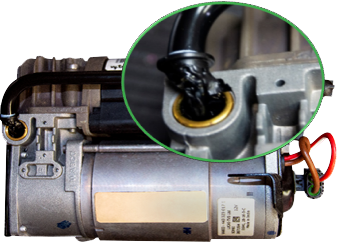
Compressor burn-out or overload is often a consequential damage which makes it crucial to check the air suspension system for possible leaks. Usually, it is easy to recognize if a compressor failed due to burn-out/overload because it smells burnt, the compressor labels have turned yellow due to the extensive heat and often the lines/connectors are partially melted as well. If this is the case, do not just install a new compressor but make sure to find the root cause. Otherwise, the new compressor will likely become defective in no time as well.
When replacing a compressor always replace the relay as well and check or replace the air filter. The compressor is switched on and off by a relay that is controlled by the Electronic Control Unit (ECU). The relay can get sticky causing the compressor to continuously pump air. This will eventually lead to a burned-out compressor. The compressor sucks and ventilates air through its air filter. If the old compressor broke down due to water and/or dirt inside, it is likely that the air filter is contaminated. If only a new compressor is replaced in such case, the new compressor will suck in the existing water/debris.

After replacing the compressor, always check the condition of the inlet and intake hoses. An intake hose can dry out and become porous causing leakage and/or they break off from the compressor. In both situations this leads to water and dirt inside the compressor causing it to break down. If left unnoticed, it will also damage the new compressor beyond repair.
Don’t forget to check the wiring loom of the compressor for possible broken or cracked wires. A compressor can vibrate when in operation causing the wiring to wear out.

This information is provided to you by Arnott – Air Suspension Products. With more than 30 years of experience in engineering, designing, and manufacturing high quality air suspension components for the aftermarket, Arnott is the technical expert when it comes to air suspension systems.



















